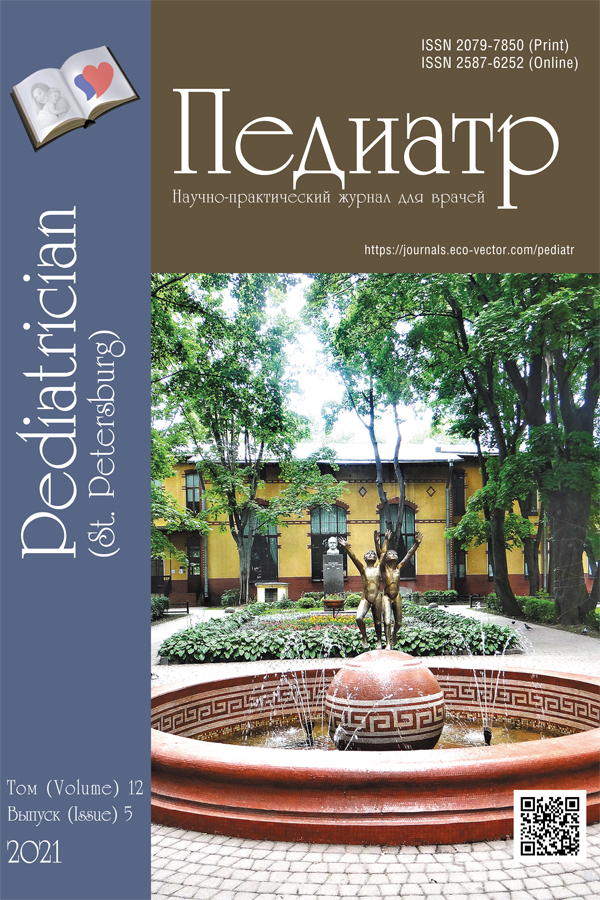关于如何在地方性疫源地以外的儿童中怀疑兔热病的研究
- 作者: Timchenko V.N.1, Barakina E.V.1, Chernova T.M.1, Bulina O.V.1, Fedyuchek O.O.2, Pochinyaeva L.M.3, Koshchavtseva M.Y.4, Shvedovchenko N.V.4
-
隶属关系:
- St. Petersburg State Pediatric Medical University
- Children’s Polyclinic No. 30
- Children’s City Clinical Hospital No. 5 named after N.F. Filatov
- Children’s City Clinical Hospital No. 22
- 期: 卷 12, 编号 5 (2021)
- 页面: 71-78
- 栏目: Clinical observation
- URL: https://journals.eco-vector.com/pediatr/article/view/104993
- DOI: https://doi.org/10.17816/PED12571-78
- ID: 104993
如何引用文章
详细
兔热病是由土拉弗朗西斯菌(Francisella tularensis)引起的一种急性人畜共患的自然发生的病灶性疾病,有多种传播机制。人类通过各种方式感染,主要是通过昆虫叮咬(蚊子、蜱虫)、直接接触受感染的动物和吸入。该病的特点是高烧、中毒、入口处的炎症变化和区域淋巴结炎。由于缺乏特殊的临床表现(发热、中毒、区域性淋巴结炎),早期怀疑兔热病往往很困难。即使在流行地区,大多数病例被诊断为急性呼吸道病毒感染、淋巴结炎和起源不明的发热,导致启动病因治疗的时间较晚。本文介绍了一个13岁儿童的兔热病的临床病例,该病例在患病初期被误诊。只有全面的流行病学史(在流行区停留,被蚊子叮咬)以及对临床和实验室数据的正确评估,才能在第18天将兔热病纳入鉴别诊断,并通过检测血清中抗土拉菌病抗体的最高滴度来确认。因此,在发病率低的背景下,特别是在儿童时期,所有专业的医生都缺乏警惕性,导致诊断过晚,结果是具体治疗开始得晚。所有长期发热并伴有起源不明的淋巴结炎的儿童,如果曾在兔热病易发区,应进行专门检查,以发现轻度和陈旧的疾病形式。
全文:
作者简介
Vladimir N. Timchenko
St. Petersburg State Pediatric Medical University
编辑信件的主要联系方式.
Email: timchenko22081953@yandex.ru
MD, PhD, Dr. Med. Sci., Professor, Head, Department of infectious Diseases in Children named after Professor M.G.Danilevich
俄罗斯联邦, Saint PetersburgElena V. Barakina
St. Petersburg State Pediatric Medical University
Email: elenabarakina@mail.ru
MD, PhD, Assistant, Department of Infectious Diseases in Children named after Professor M.G. Danilevich
俄罗斯联邦, Saint PetersburgTatyana M. Chernova
St. Petersburg State Pediatric Medical University
Email: detinfection@mail.ru
MD, PhD, Associate Professor, Department of Infectious Diseases in Children named after Professor M.G. Danilevich
俄罗斯联邦, Saint PetersburgOksana V. Bulina
St. Petersburg State Pediatric Medical University
Email: detinfection@mail.ru
MD, PhD, Associate Professor, Department of Rehabilitation FP and DPO
俄罗斯联邦, Saint PetersburgOlga O. Fedyuchek
Children’s Polyclinic No. 30
Email: detinfection@mail.ru
infectious disease doctor
俄罗斯联邦, Saint PetersburgLyubov M. Pochinyaeva
Children’s City Clinical Hospital No. 5 named after N.F. Filatov
Email: detinfection@mail.ru
doctor, Deputy Chief Physician for the Medical Part
俄罗斯联邦, Saint PetersburgMarina Y. Koshchavtseva
Children’s City Clinical Hospital No. 22
Email: detinfection@mail.ru
doctor of the highest category, Head of the Infectious-Boxed Department
俄罗斯联邦, Saint PetersburgNatalya V. Shvedovchenko
Children’s City Clinical Hospital No. 22
Email: detinfection@mail.ru
doctor of the Infectious-Boxing Department
俄罗斯联邦, Saint Petersburg参考
- Infekcionnye bolezni u detej. Uchebnik 4-е izd. Timchenko VN. editor. Saint Petersburg; 2012. P. 526–533. (In Russ.)
- Klinicheskie rekomendacii po diagnostike limfadenopatij. Nacional’noe gematologicheskoe obshhestvo. 2014. 38 р. (In Russ.) Available from: https://blood.ru/documents/clinical%20guidelines/13.%20klinicheskie-rekomendacii-2014-lap.pdf
- Meshherjakova IS, Dobrovol’skij AA, Demidova TN, et al. Transmissible epidemic outbreak of tularemia in Khanty-Mansiysk in 2013. Epidemiology and Vaccine Prevention. 2014;(5):14–20. (In Russ.)
- O sostojanii sanitarno-jepidemiologicheskogo blagopoluchija naselenija v Rossijskoj Federacii v 2019 godu: Gosudarstvennyj doklad / Federal’naja sluzhba po nadzoru v sfere zashhity prav potrebitelej i blagopoluchija cheloveka. Moscow; 2020. 299 р. (In Russ.) Available from: https://www.rospotrebnadzor.ru/documents/details.php? ELEMENT_ID=14933
- O sostojanii sanitarno-jepidemiologicheskogo blagopoluchija naselenija v Respublike Karelija v 2019 godu: Gosudarstvennyj doklad / Upravlenie Federal’noj sluzhby po nadzoru v sfere zashhity prav potrebitelej i blagopoluchija cheloveka po Respublike Karelija. Petrozavodsk; 2020. 173 р. (In Russ.)
- Syrova NA, Tereshkina NE, Devdariani ZL. Current State of Tularemia Immunodiagnostics. Problems of Particularly Dangerous Infections. 2008;(3):12–15. (In Russ.) doi: 10.21055/0370-1069-2008-3(97)-12-15
- Tuljaremija. Upravlenie Rospotrebnadzora po respublike Marij Jel. Jepidemiologicheskij nadzor. Available from: http://12.rospotrebnadzor.ru/bytag2/-/asset_publisher/x85V/content/туляремия. (In Russ.)
- Antonitsch L, Weidinger G, Stanek G, et al. Francisella tularensis as the cause of protracted fever. BMC Infectious Diseases. 2020;20(1):327. doi: 10.1186/s12879-020-05051-1
- Balestra A, Bytyci H, Guillod C, et al. A case of ulceroglandular tularemia presenting with lymphadenopathy and an ulcer on a linear morphoea lesion surrounded by erysipelas. International Medical Case Reports Journal. 2018;11:313–318. doi: 10.2147/IMCRJ.S178561
- Caspar Yv, Maurin M. Francisella tularensis Susceptibility to Antibiotics: A Comprehensive Review of the Data Obtained In vitro and in Animal Models. Front Cell Infect Microbiol. 2017;7:122. doi: 10.3389/fcimb.2017.00122
- Claviez A, Behrends U, Grundmann T, et al. Lymphknotenvergrößerung. Die Leitlinie (Fünfte Fassung). AWMFonline: 2020. Available from: https://www.awmf.org/leitlinien/detail/ll/025-020.html (In German)
- Darmon-Curti A, Darmon F, Edouard S et al. Tularemia: A Case Series of Patients Diagnosed at the National Reference Center for Rickettsioses From 2008 to 2017. Open Forum Infectious Diseases. 2020;7(11):ofaa440. doi: 10.1093/ofid/ofaa440
- Hestvik G, Warns-Petit E, Smith A.L, et al. The status of tularemia in Europe in a one-health context: A review. Epidemiology and Infection. 2014;143(10):137–160. doi: 10.1017/S0950268814002398
- Lang S, Kansy B. Cervical lymph node diseases in children. GMS Curr Top Otorhinolaryngol Head Neck Surg. 2014;13: Doc08. doi: 10.3205/cto000111
- Mani Rinosh J, Morton Rebecca J, Kenneth D. Ecology of Tularemia in Central US Endemic Region. Current Tropical Medicine Reports. 2016;3:75–79. doi: 10.1007/s40475-016-0075-1
补充文件







